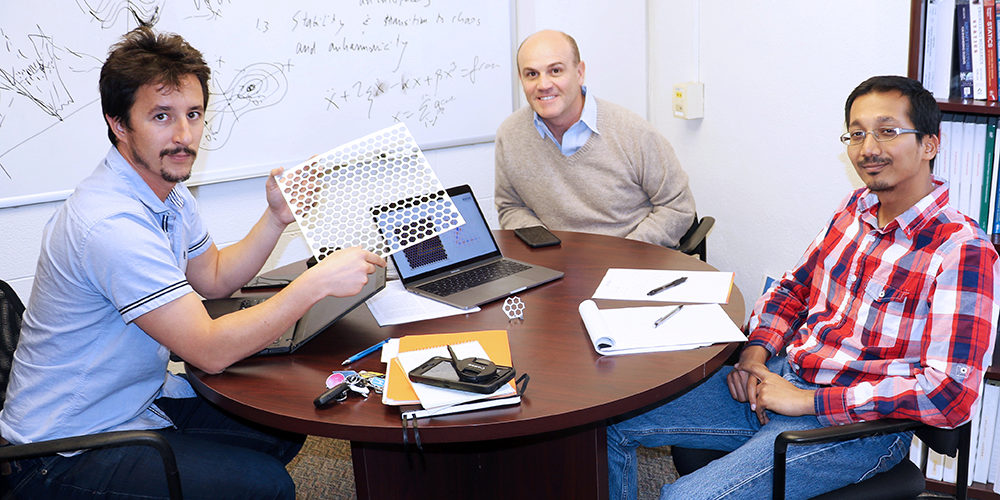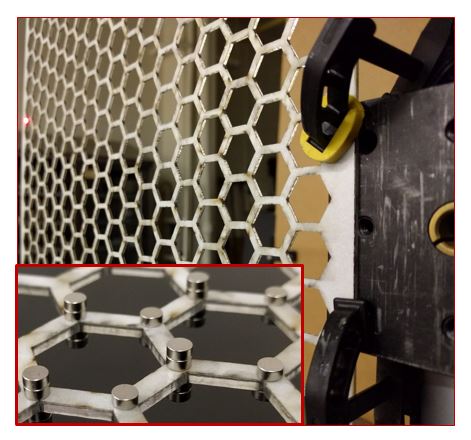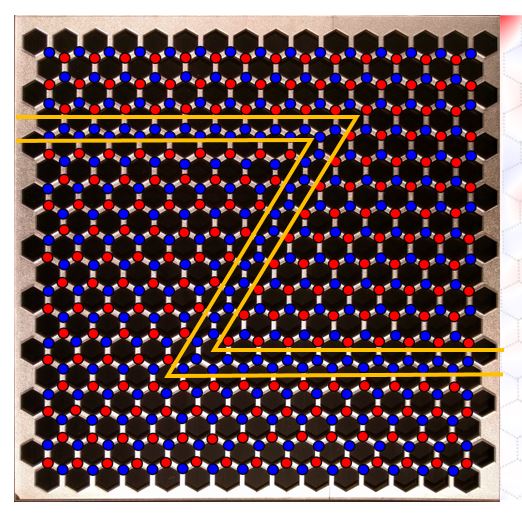 |
| Making Waves. Prof. Massimo Ruzzene, center, with his research colleagues, Drs. Javier Vila, left, and Raj Kumar Pal. The trio have simulated new ways to control wave energy, an area that impacts many aspects of modern technology, including circuits, filters, logic operators, and, yes, cellphones. |
When AE professor Massimo Ruzzene dropped his cellphone a few months back, the cracks that quickly spread across his screen confirmed two things: (1) time for a new cell phone and (2) his research on topological metamaterials has obvious marketability.
“Our work focuses understanding and manipulating mechanical waves – like the ones that worked their way across my screen,” said Ruzzene, the head of AE’s Wave Propagation Lab. “If you can control where the energy goes – make it go around, not inside or on the screen -- then there are a lot of potential advantages in terms of preventing damage to the phone.”
Or damage to a rotor.
Or damage to a fuselage.
 |
| Simulating Mass Distribution. Dotted with tiny magnets, the acrylic lattice that the Wave Propagation Lab developed enables them to model new wave interfaces. |
“The idea is, let’s say your plane is hit by a bird while in flight. That impact creates a series of effects -waves that travels through the wing, causing vibrations, and often leading to failure. It is a dynamic event. If we can control how the energy of the impact gets distributed through the structure, then we can have a huge effect on how airplanes are designed. And ultimately, on their safety.”
The ultimate applicability of these concepts to real-world problems is clear. What’s not so obvious is how Ruzzene and his fellow researchers, post-docs Raj Kumar Pal and Javier Vila, got started on this vein of research. Their current focus leans more towards physics than traditional engineering.
“Our work is inspired by what happens at the atomistic level. There are these exotic crystals, graphene-like materials, that don’t conduct current when you look at them as infinite materials. In the bulk, they are like wood,” says Pal.
“But if you cut them and make them finite, they become superconducting at the boundaries, and they conduct current in a very robust way. These crystals are called 'topological insulators'."
Physicists researching the conductive properties of topological insulators and of graphene inspired Ruzzene and his team to take things a step further: how can the concepts behind these unique properties be extended to mechanical systems, to redirect waves along a defined path?
“We’re looking at the properties and interactions at an atomistic scale so that we can replicate them and achieve similar behavior in mechanical structures” said Vila.
“So we’re interested in tailoring the way these materials conduct elastic waves, which is an analog of electrical current. In an atomistic system, the energy transferred by electrons forms electricity. For us, it’s not electricity but mechanical perturbations [vibrations] that travel from one place to another. This has relevance because it gives us an opportunity to either dissipate or isolate that energy [vibrations] along a predefined path.”
To that end, the team has been generating mechanical models of graphene-like structures on the computer, paying careful attention to their highly symmetric, hexagonal configuration. They have also used the Aero
 |
| Counterintuitive from a Mechanical Engineering Perspective. The Z-shaped path that waves travel through this material is defined by manipulating the mass distribution.The creation of these unusual wave interfaces opens many possibilities for researchers - and industry. |
Maker Space to construct a physical model of a graphene-like system– an acrylic hexagonal lattice that has tiny magnets affixed at different junctures to mimic the unique conductive interfaces that can be created.
“Instead of confining the waves to run along the boundaries that occur at the edge, as in topological insulators, we can introduce a discontinuity inside the material that will create a new conductive interface. We do this by changing the distribution of masses, which in graphene systems is accomplished by stacking multiple layers.”
In the model, discontinuity is simulated by placing the magnets in different locations, a move that has allowed them to define paths that don’t just run around the boundaries of the material, but through it as well.
“We have been able to create a Z-shape, which is very counterintuitive from a mechanical standpoint because waves usually do not go around a corner,” says Ruzzene. “But even a straight line path is interesting because there’s nothing physically restraining it along that line. We’re just manipulating it by manipulating the mass distribution.”
As the team becomes more successful at defining and manipulating new paths for vibrational energy, they have no doubt that industry will be interested in the results. The diversion of deleterious wave energy could prevent damage in everything from cellphones to airplanes. Their work has already garnered the support of the Army Research Office, the National Science Foundation and the Air Force Research Lab.
But it could also serve a more pro-active function - providing a new means for effectively transferring information. Without wires, tubes, or hardware, these newly defined interfaces could transfer information with unprecedented levels of robustness and efficiency.
“That’s why we are doing fundamental research,” says Ruzzene.“You let the structure do the work."